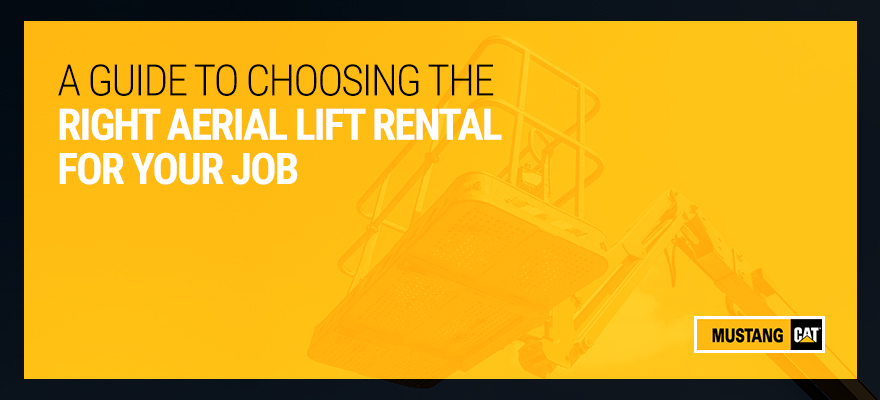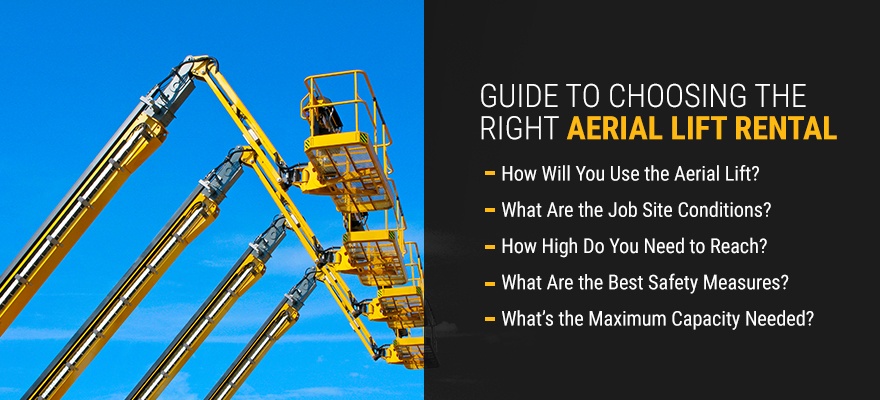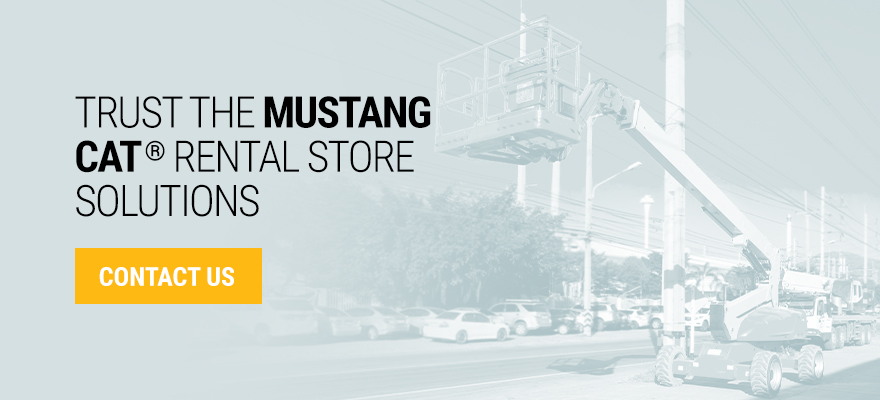A Guide to Choosing the Right Aerial Lift Rental for Your Job

Choosing the right aerial lift rental can feel high-stakes, especially if you’re a first-time renter. Different units are ideal for different applications, such as indoors versus outdoors, job site conditions and height. The first step is to consider the environment of your job site. From there, think about what materials you’ll be lifting and the various safety factors involved in operating heavy equipment.
A Guide to Choosing the Right Aerial Lift Rental for Your Job
Choosing the right aerial lift rental can feel high-stakes, especially if you’re a first-time renter. Different units are ideal for different applications, such as indoors versus outdoors, job site conditions and height. The first step is to consider the environment of your job site. From there, think about what materials you’ll be lifting and the various safety factors involved in operating heavy equipment.
Having a guide to aerial equipment rentals can help you determine which solution is best for your projects. Knowing how to rent aerial equipment that best suits your operations can also keep you within deadlines, help you maintain a safe area and support your bottom line. The Mustang Cat® Rental Store is a solutions-based dealer that gives you access to top-of-the-line equipment. Our experts are here to assist you in finding the right lift for your business.

Guide to Choosing the Right Aerial Lift Rental
Aerial lifts are unique pieces of equipment that allow you to access higher areas, such as ceilings, roofs, lighting fixtures and more. Except for a scissor lift rental, aerial lifts have a boom, which is an extendible arm that lifts a work platform to various heights to help you reach tricky workspaces. Also known as cherry pickers, boom lifts or bucket lifts, aerial lifts can make your job exceedingly easier.
These machines come in many sizes and forms with different features available and can accommodate various applications. Operators use aerial lifts to maneuver around confined spaces or around ground obstacles, all while lifting workers to areas that are otherwise inaccessible with scaffolding.
When renting an aerial lift, consider these different aspects so you can invest in the best unit for your projects:
1. How Will You Use the Aerial Lift?
Knowing your intended application is the first step in renting an aerial lift. Will you be performing light-duty work or lifting heavy objects at different heights? Will you need integrated tools like saws, welders or lighting packages? Will your accessories require diesel generators or electrical cables? Integrated tool systems can support your various needs to boost construction machinery productivity and eliminate the need for other solutions.
2. What Are the Job Site Conditions?
Do most of your operations occur inside or outside? Indoor sites often require electric or propane sources, while outdoor operations can run on fuel like diesel or gas. Site conditions also determine whether the aerial lift will benefit from non-marking tires, tracks, two-wheel-drive or four-wheel-drive. For example, sloped conditions often require tracked aerial lifts because they can easily operate on different grades. However, a four-wheel-drive machine may be better for muddy terrain and for a higher clearance over debris.
If equipment with tires better fits your job site conditions, consider pneumatic, foam-filled, non-marking or high flotation options for different turf. Thinking about your job site conditions also relates to any limitations your operators may face. Are there higher obstructions like power lines or ground objects like materials and other machinery you need to maneuver around? To move in and out of a building, what is the door access like? For electric engines, do you have enough power generation available for them to repower and run up to 10 hours a day?
3. How High Do You Need to Reach?
How high you need to reach for different tasks is one of the most common questions, but people often miss a crucial consideration. Know the height you need to reach, as well as the average height of an operator. Often, you can rent an aerial lift with a shorter maximum height to be more cost-effective while relying on the additional height of your workers.
The max height you need to reach also relates to the type of surface you’re on and how much weight the boom can handle and different levels.
4. What Are the Best Safety Measures?
Before renting any type of heavy equipment, make sure your operators are trained. Proper education ensures the safety of your workers and other people on-site and increases productivity levels. Training involves things like how to properly operate the equipment, common hazards, inspecting the site and machine before use, proper loading and unloading of materials and how to respond in emergency situations.
Check all of the possible hazards that are related to construction site safety like obstacles, treacherous terrain and tall hazards. If you have major concerns, discuss them with us and we can determine the best safety features available. For example, outriggers are great at keeping aerial lifts stable on uneven surfaces or while you’re lifting heavier materials.
5. What’s the Maximum Capacity Needed?
Finally, how many people need to be on the machine at once? How heavy is the material you’re lifting? Consider the lift weight, how much material you need to life and how many people your aerial lift rental can handle.
Think about these questions to help you narrow down your aerial lift options. Having a guide to aerial equipment rentals and partnering with a reputable dealership will give you the best solution that fits your needs.
Renting the Right Aerial Lift
Here’s a brief overview of different units and their recommended applications:
- Articulated boom lift: A unit with a jointed boom that’s great for reaching areas with obstructions for maximum flexibility.
- Atrium lifts: A machine best suited for vertical movements and narrow workspaces thanks to its compact size.
- Personnel lifts: A lift ideal for indoor use for a single person and light construction work.
- Rough terrain lifts: A machine outfitted to work outdoors in uneven and harsh environments like gravel and dirt.
- Scissor lifts: A vertical lift available in electrical or rough terrain models that have a base and platform of the same size — a step up from scaffolding.
- Telescopic lift: A lift that extends horizontally up and down for outreach applications.
- Vertical lift: A unit ideal for overhead projects.
When you rent construction equipment this gives you the freedom to choose the length of your agreement and is ideal for short-term or one-time projects.
Trust The Mustang Cat® Rental Store Solutions
As a family-owned Cat dealer since 1952, we give you access to aerial lift rentals to support your operations. With reliable warranties and industry-leading response times, The Mustang Cat Rental Store sells Cat equipment and other machines, like JLG Aerial Equipment.
Reach out to us online to learn more about renting a lift, or check out our rental locations. Our professional team of experts will guide you in making the best decision that matches your uses and budget.



